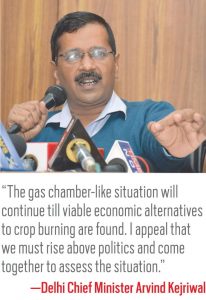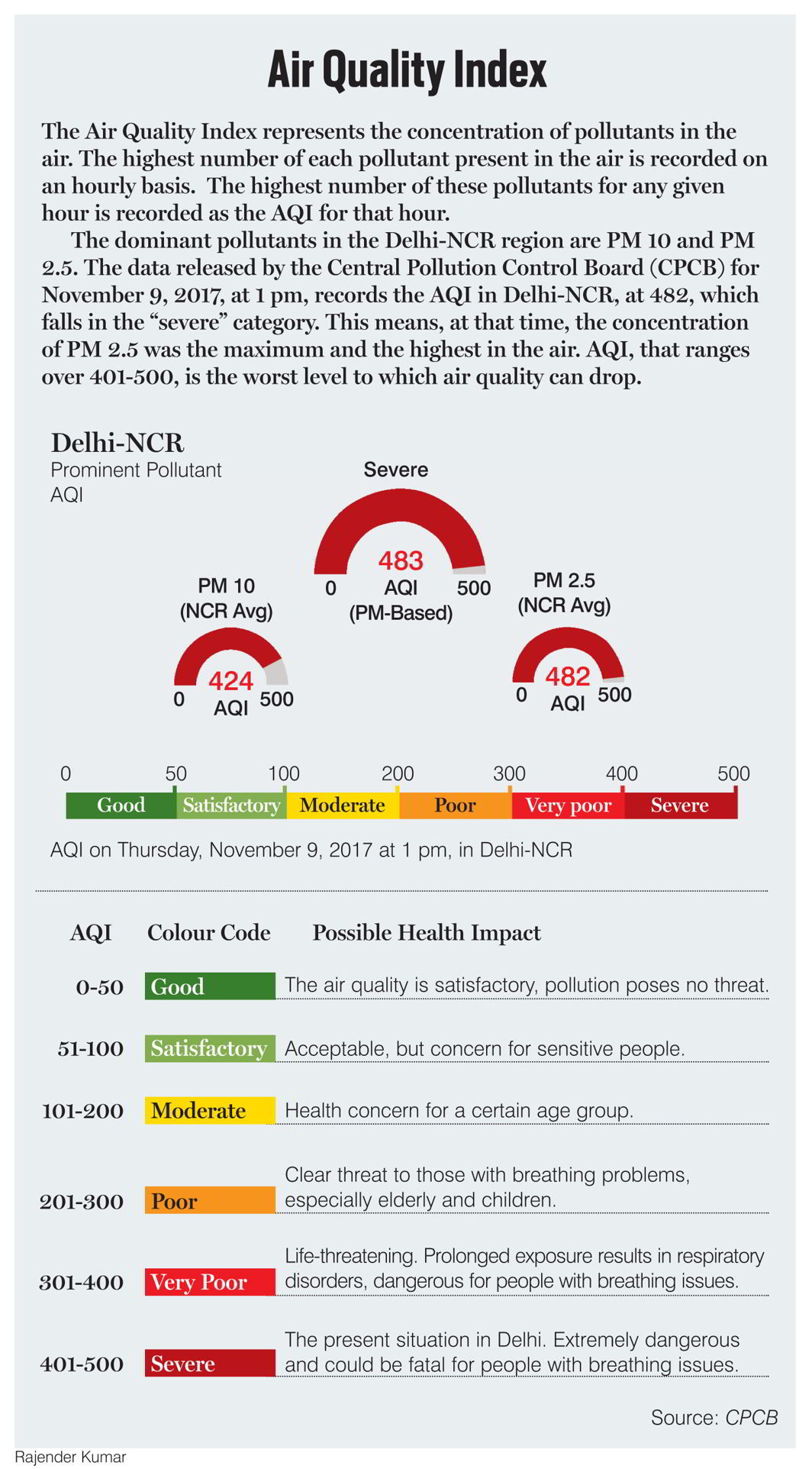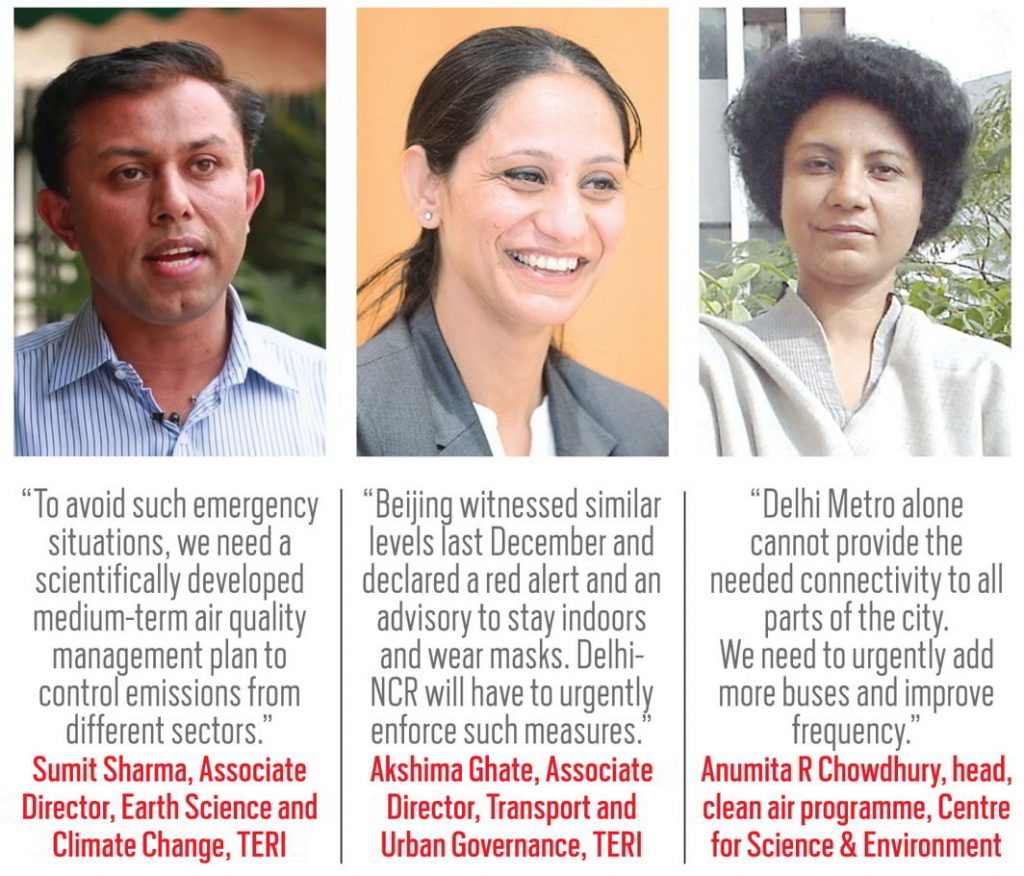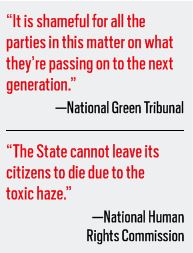Above: Vehicular traffic crawling on the Agra-Delhi National Highway due to the dense smog. Photo: UNI
Year after year, Delhi-NCR region suffers from the deleterious effects of smog due to wrong policies on vehicular traffic, garbage disposal and stubble burning, leading to an environmental emergency
~By Ramesh Menon
As air quality in Delhi and surrounding areas in the National Capital Region (NCR) plummetted to dangerous levels, residents found themselves choking, suffering from headaches, running noses, respiratory problems and burning eyes. The Indian Medical Association (IMA) and health experts labelled it a public health emergency. The deadly level of carcinogenic pollutants in Delhi’s air was roughly 10 times the reading in Beijing, a city globally infamous for its air pollution and seen as one of the most polluted in the world.
The National Green Tribunal (NGT) demanded to know from the Delhi government what steps it had taken to curtail pollution, the number of challans issued to violators and the number of construction sites where work has been stopped. The NGT pulled up both the Delhi government and the Central Pollution Control Board for not issuing orders to shut down construction and industrial activities in the capital despite worsening air quality.
 The NGT also directed that industrial activities should not be carried out in Delhi till the next hearing. It also ordered that public authorities depute an officer to monitor polluting activities. There is reason to worry if one lives in this heavily polluted region. According to health experts, it can affect lung function and result in respiratory problems, asthma, chronic cough and cold, breathlessness and even heart attacks. “The situation today is the worst I have seen in my 35 years living in Delhi,” said Arvind Kumar, a lung surgeon at Sir Ganga Ram Hospital. “As a doctor, I have no problem saying that the situation is a public health emergency. If we want to protect people, we should be ordering the evacuation of Delhi. Close down all schools and offices.”
The NGT also directed that industrial activities should not be carried out in Delhi till the next hearing. It also ordered that public authorities depute an officer to monitor polluting activities. There is reason to worry if one lives in this heavily polluted region. According to health experts, it can affect lung function and result in respiratory problems, asthma, chronic cough and cold, breathlessness and even heart attacks. “The situation today is the worst I have seen in my 35 years living in Delhi,” said Arvind Kumar, a lung surgeon at Sir Ganga Ram Hospital. “As a doctor, I have no problem saying that the situation is a public health emergency. If we want to protect people, we should be ordering the evacuation of Delhi. Close down all schools and offices.”
AIR QUALITY
Unfortunately, the haze has refused to go away. It ominously hung around the NCR, leading to Delhi’s air quality index shooting to dangerous levels in the first week of November. It was even worse than the day after Diwali when pollution always peaks. The situation was so bad that Delhi’s deputy chief minister, Manish Sisodia, requested city dwellers to avoid venturing outside and not even go for morning or evening walks. The air quality in Gurugram and Noida was worse than Delhi. Dr KK Aggarwal, president of IMA, said that people must avoid exercising as it would call for heavy breathing which would mean ingesting more pollutants.
Meanwhile, the Environmental Pollution Control Authority (EPCA) has asked the government to quickly undertake drastic measures like hiking parking fees, shutting down hot mix plants and stone crushers and brick kilns.
Akshima Tejas Ghate, Associate Director, Transport and Urban Governance, TERI, told India Legal: “Beijing witnessed similar levels last December and declared a red alert, which called for the closure of schools, reduction of vehicular activity and an advisory to stay indoors and wear masks. Delhi-NCR will have to urgently enforce such tough measures in the larger public interest.”
NGT ORDER
No one was surprised by the haze. It had descended on Delhi last year too. And everyone was aware of why it was happening. No wonder the National Green Tribunal pulled up the governments of Delhi, Punjab, Uttar Pradesh and Haryana, asking them what they had done in anticipation of an environmental emergency. They had no answers.
 Last year, this emergency necessitated the closure of schools as children would be the most affected. Again, there were knee-jerk reactions. The Delhi chief minister called the capital a gas chamber and tweeted that he had asked the chief ministers of Punjab and Haryana for a meeting to discuss a solution to the stubble burning problem in their states. He could have done it earlier as it was obvious that such a situation would arise.
Last year, this emergency necessitated the closure of schools as children would be the most affected. Again, there were knee-jerk reactions. The Delhi chief minister called the capital a gas chamber and tweeted that he had asked the chief ministers of Punjab and Haryana for a meeting to discuss a solution to the stubble burning problem in their states. He could have done it earlier as it was obvious that such a situation would arise.
Sumit Sharma, Associate Director, Earth Science and Climate Change, TERI, told India Legal: “To avoid such emergency situations, we need a scientifically developed medium-term air quality management plan to control emissions from different sectors. Just concentrating on Delhi will not help as areas around need as much attention. I stay at Indirapuram, two kilometres from Delhi’s border, and see garbage burning on both sides of the road. The management plan has to be regional in nature as biomass burning is rampant in NCR and around it.”
Justice Swatanter Kumar, chairperson of the NGT, said that the air quality was so poor that children were finding it difficult to breathe. The NGT was hearing a plea filed by environmental activist Akash Vashishta asking for immediate action. He wanted the government to put a cap on the number of vehicles in Delhi to curb pollution. The capital has over 1,200 new vehicles registered every day. This is much more than the total number of vehicles registered in Mumbai, Kolkata and Chennai.
You Reap What You Sow
Paddy straw can be used in biomass power plants which are not difficult to set up or operate
 Delhi was the most polluted city in the world on November 8, 2017, according to reports. There are loud cries of alarm today about the capital’s insufferable pollution but as this will lessen after a week or two, people will soon forget the causes of the crisis as they have during the past several years. While this pollution is caused by construction dust, auto pollution, common road dust, and so on, the problem increases hugely from mid-October till mid-November due to crop burning in most of the Yamuna river plains. Winds blowing from the north-west then cover Delhi and other areas with fine soot particles that are harmful for our lungs.
Delhi was the most polluted city in the world on November 8, 2017, according to reports. There are loud cries of alarm today about the capital’s insufferable pollution but as this will lessen after a week or two, people will soon forget the causes of the crisis as they have during the past several years. While this pollution is caused by construction dust, auto pollution, common road dust, and so on, the problem increases hugely from mid-October till mid-November due to crop burning in most of the Yamuna river plains. Winds blowing from the north-west then cover Delhi and other areas with fine soot particles that are harmful for our lungs.
The main culprit is paddy straw that is harvested in Punjab, Haryana and western UP from mid-October. This problem has worsened in recent years because of several reasons. The first is that almost all the paddy is harvested by combine harvesters that collect the grain but dump the useless broken straw on the fields. Combines also cut the straw about 30 cm above the ground, so farmers have to also cut off this stubble before they can plant their wheat crop that has to be sown by November 10.
Second, almost all the plowing and sowing is now done by tractors, making bullocks totally redundant. Plowing by bullocks and bullock carts have almost disappeared in rural India. Earlier, most of the paddy straw would be used as cattle fodder, but buffaloes, unfortunately, find its high silica content difficult to digest.
Progress has also resulted in thatched village huts giving way to pucca brick buildings that do not need straw thatching. Thatching is now easily done with plastic sheets. Burning of straw and stubble is, therefore, the only available solution as farmers have to complete the operation before mid-November or they will not be able to sow their wheat crop. They have very few options and will continue this burning unless the government reduces paddy cultivation or pays farmers huge sums to keep their fields fallow. Steps that would be very difficult politically.
It will be difficult for governments to do anything about this problem because there is no way that their limited manpower and police can enforce any ban. A rural district is a huge area and there are roughly 40 paddy growing districts in Punjab, Haryana and western UP. Each is about 6,000 sq km with about a million villagers. The police also often comes from the same farmer stock and is too sympathetic to their difficulties to effectively enforce any bans or fines.
It is a difficult problem and there are no easy solutions. The tragedy, however, is that the waste straw is a huge potential source of green energy. This year, Punjab will have a yield of nearly 19 million tonnes (mt) of rice and about 40 mt of paddy straw, of which about 30 mt will go waste. So the waste straw of the three states will be roughly 75 mt, which is equivalent to roughly 40 mt of coal that is capable of generating almost 40,000 MW of electricity (13 percent of India’s total electricity production).
Biomass power plants are not difficult to build or operate. A 12 MW plant like that of Punjab Biomass Power Limited, near Patiala, has been operating effectively and profitably. It generates about 2,00,000 units a day from 1,20,000 tonnes of straw that it collects every year. Projects like this can be set up in 18 months if given all the clearances. Despite encouragement from the highest levels in Punjab, the project was unfortunately plagued with petty bureaucratic hurdles, resulting in heavy initial losses that were a deterrent to other investors.
Biomass projects are not, however, easy as straw and other agricultural waste collection is difficult in the short window of the seasons when farm labour is scarce. With whole-hearted support, about 200 similar plants can be quickly set up in these paddy growing areas and this can quickly reduce though not completely eliminate the problem.
—By Murad Ali Baig
TRANSPORT ISSUES
It has been like this for years. Even though many vehicles have shifted to CNG, it has not helped as vehicular numbers are rising day by day. In the last two years, the number of taxis has also swelled to over 1,10,000. Adding to this are toxic fumes from industrial pockets in Delhi and the NCR.
There are other factors too. The EPCA points out that the Delhi government has not acquired new buses in the last three years, leading to a shortfall in the mass transport system. Since 2013, bus ridership has been declining at an average rate of 9 percent per annum. Overall, it has dropped by as much as 34 percent. According to the latest data available (November 2016), the system handles 30.33 lakh passengers daily. At the same time, bus numbers have also dwindled.
Anumita Roy Chowdhury, who heads the clean air programme at the Centre for Science and Environment, said: “Delhi Metro alone cannot provide the needed connectivity to all parts of the city. We need to add more buses and improve frequency. A massive augmentation of public transport is needed. Not a single bus has been procured in Delhi over the last three years. This has added to the pollution crisis.”
20 SOLUTIONS
- Improve public transport so that owning cars will not be a necessity.
- Make parking and registration of vehicles expensive.
- Suspend driving licences and registration of polluting vehicles.
- Give incentives to petrol-driven vehicle owners in terms of tax cuts and cheaper fuel.
- Remove all abandoned unused vehicles that owners have parked on roadsides after penalising them.
- Build new modern automated parking plazas with multiple floors.
- Make unauthorised parking on roads impossible by imposing heavy fines.
- Repair roads as potholes and broken patches slow down traffic and cause emissions.
- Enact a law that ensures all trucks carrying sand, garbage, mud and concrete waste are fully covered.
- Heavily penalise real estate companies which spread dust on roads.
- Do not permit new construction unless parking is also built and there is a guarantee by the owner of the property that no vehicles will be parked on the road.
- Have Quick Response Teams near all traffic hotspots to ensure zero congestion.
- Heavily penalise those who burn garbage, dry leaves or anything else by the road.
- Have mechanised garbage disposal systems.
- Recycle all garbage.
- Invest in expanding Metro services and make it affordable for all.
- Eateries should only use gas for cooking. Ban the use of coal and firewood for cooking.
- Close down brick kilns in and around the NCR.
- Work on long-term power generation methods using clean energy so that diesel-operated generator sets are phased out.
- Initiate research on how biomass burning can be avoided by employing eco-friendly methods.
STUBBLE TROUBLE
One of the major factors leading to pollution is stubble burning. The NGT had earlier ordered that stubble should not be burnt but farmers in Haryana and Punjab defied it, asking the police to arrest them. As they readied their fields for the next sowing season, farmers were jointly setting fire to stubble in their fields in the last few weeks. They said they needed to be compensated as manual disposal of the stubble would entail huge labour costs. The government has no infrastructure to reach every field and remove the dry stalks left after harvesting in an eco-friendly manner.
 Kejriwal said that if the central government, Uttar Pradesh, Punjab and Haryana governments put politics aside, a solution could be found. He had a point when he emphatically said that until state governments found economically viable solutions to crop burning, it would not stop. News agency ANI reported on November 9 that despite rapidly deteriorating pollution levels, stubble burning in Haryana continued.
Kejriwal said that if the central government, Uttar Pradesh, Punjab and Haryana governments put politics aside, a solution could be found. He had a point when he emphatically said that until state governments found economically viable solutions to crop burning, it would not stop. News agency ANI reported on November 9 that despite rapidly deteriorating pollution levels, stubble burning in Haryana continued.
It is, however, just not the stubble that is the villain. The capital and the NCR also choke with construction dust from real estate projects, vehicular pollution, burning of rubbish due to lack of a modern garbage collection system, careless transportation of mud and construction waste, burning of dry leaves and so on. All of this can be stopped by a strong administration that has the political will to do it. (See box)
Chowdhury said that studies have shown that hospital admissions rise when air pollution levels go up. “The decision to close schools is only a temporary measure. What is important is to prevent children from exposure, from breathing the polluted air. In fact, closing schools may trigger greater exposure as children spend free time playing outdoors,” she revealed.
EPCA member and director general of Centre for Science and Environment Sunita Narain stressed that unless the agenda to introduce massive public transport, stop burning of garbage, transit to cleaner fuels and ban pet coke and furnace oil use was implemented, air quality would not improve. “Cities and administrations need to implement solutions and take bold decisions to reduce emissions. It is now up to the political leadership of Delhi and the NCR to take their implementation forward,” she said.
Nearly 92 percent of the world’s population lives in areas where the air quality is below WHO standards. About 88 percent of premature deaths occur in the low and middle-income countries, where air pollution is escalating at an alarming rate. What we are seeing today will be replicated next year too unless drastic measures are taken to deal with the problem. That requires political will and determination.


